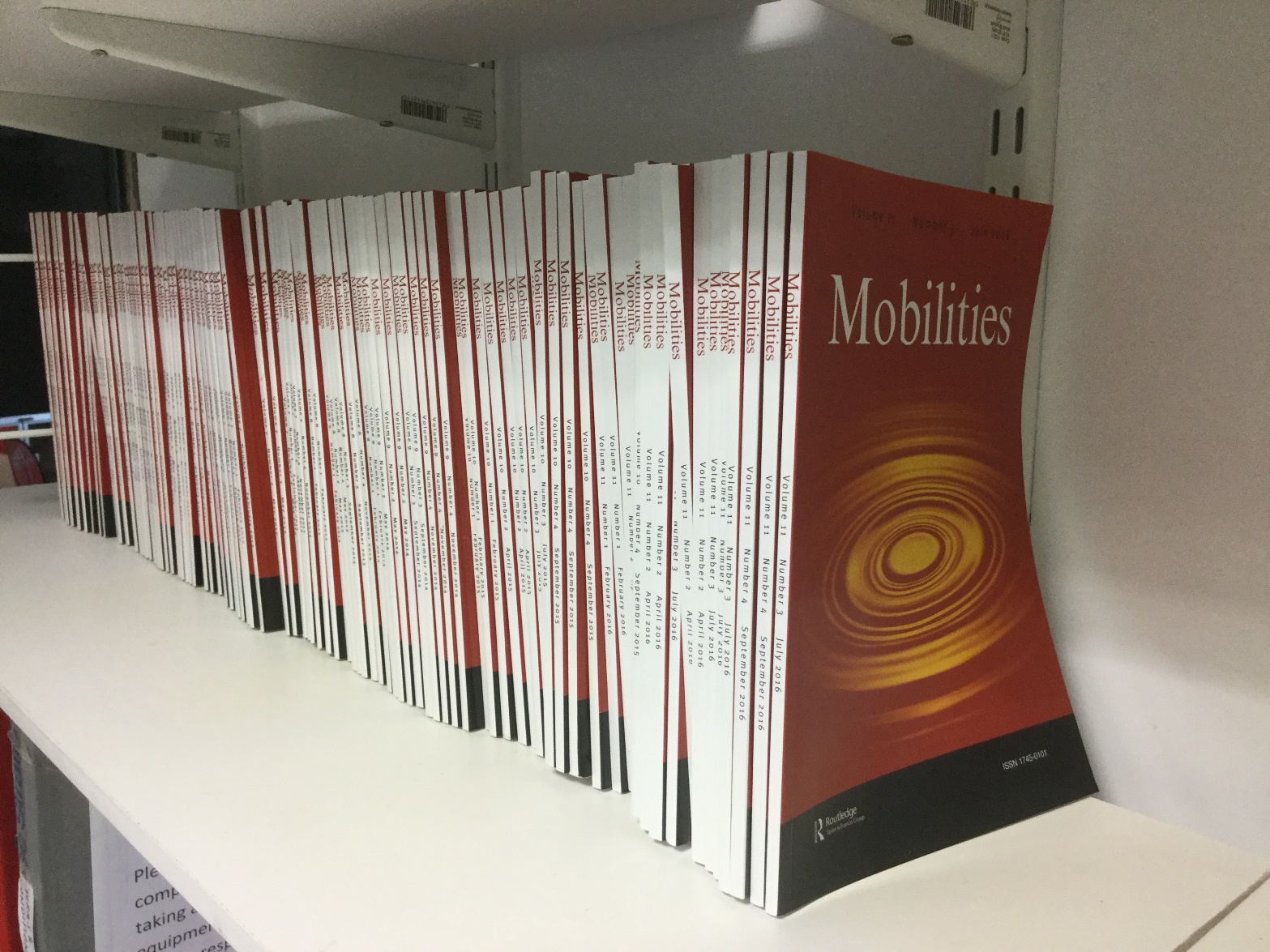Allison Hui and James Faulconbridge have co-ordinated the 10th anniversary special issue of Mobilities journal. In this blog post, Allison summarises the exciting yet difficult task of selecting the papers that best describe a decade of mobilities research.
Being tasked with the job of reflecting upon a field as eclectic as mobilities research in my experience sparked both excitement and distress in equal measures. It was thus early on in the process of developing our recent 10th anniversary special issue of Mobilities that co-editor James Faulconbridge and I embraced the mess and absence that John Law notes are a part of any method (2004) (1). We would simply never ‘cover it all’ or include all of the exciting threads of research that have emerged in the past decade. Nor could we provide any kind of definitive summary of the contributions of this multi-disciplinary field, given the fact that what are innovations in one (sub)disciplinary field can be established truisms in another. Thus we turned to pursue two different trajectories – one curating the inevitably partial traces of this mobile field as they emerged within contributors’ papers and the other reflecting upon the field’s internal dynamics and their implications for the future.
The excellent set of papers within the special issue are well worth a read, as they epitomize some of the most influential work of the last decade of mobilities research while also developing distinctly new arguments about power, politics, exceptional cases, urban environments, embodied experiences, and how diverse actors engage with imaginings of the future.
In this post I won’t re-hash the details of each trajectory, as we address both at some length in our editorial introduction (Faulconbridge and Hui 2016). Needless to say, the excellent set of papers within the special issue are also well worth a read, as they epitomize some of the most influential work of the last decade of mobilities research while also developing distinctly new arguments about power, politics, exceptional cases, urban environments, embodied experiences, and how diverse actors engage with imaginings of the future within cases of disease, emergencies, aeromobilities, migration, infrastructure, locative media encounters, walking, space tourism and automobility. Rather, I will briefly highlight three issues that emerged out of these contributions and the convergence of the two trajectories.
Firstly, it is striking that interdisciplinary research traditions, such as mobilities studies, seem more often praised for their possibility than lamented for their demands. I do not mean to suggest that they are not spaces holding great opportunities – indeed the confluence of scholars, ideas and approaches that come together within eclectic interdisciplinary centers, conferences and journals facilitate new connections and discussions that might be marginalized in established fields. Yet alongside these opportunities exist a range of challenges – not the least of which is the crafting of justifiable summaries of what mobilities research is. While it is relatively common, and easy, to point to key markers, such as the dubbing of this area of research (Sheller and Urry 2006), or major retrospective volumes (Adey et al. 2014), it is comparatively rare to see references to the evolution or transformation of this stream of work. That is, many accounts of mobilities research are surprisingly static – fixed to landmark publications rather than tracing the waxing and waning of subtler trajectories across (and not only within) areas of empirical study. As James and I note in our introduction, however, this could in part be tied to where mobilities research is within its own path of development, and could change as attention shifts from defending the field as a whole to consolidating sub-areas within it. Thinking about how our location within evolving research traditions shapes assessments and representations of them is thus an important part of noting the creation of absences and presences in our research.
Secondly, it remains a source of vibrancy that mobilities research can engage with questions having diverse ontological, epistemological and methodological heritages and implications. The special issue papers consider not only questions of embodied experiences and how social interaction is shifting in a digital world, but also those related to the processes embedded in complex political and socio-technical systems, how they draw upon rich discursive imaginaries and call for sensitive conceptualization. As James and I note, however, there is a balance to be struck as some degree of coherence is required to maintain interest within the field of mobilities research, at the same time that too much closure – around for instance a ‘canon’ of theorists – could eliminate this important diversity.
Thirdly then, we argue in our introduction that it is important for the future of mobilities research that scholars engage with not only new questions emerging from a range of empirical cases on particular modes and practices of transportation (walking, driving, flying) or nexus of mobilities (related for instance to emergencies, governance, infrastructure) but also those emerging from a reflexive attention to the stakes and trajectories of interdisciplinary research itself. While questions emerging from such considerations are multiple, the special issue engages in particular with four:
-
“How might mobilities research remain exciting and compelling, while taking seriously the power dynamics that mark both research practices and the cases they study?
-
To what extent has mobilities research not only challenged some assumptions and boundaries, but also started to reproduce others?
-
To what extent is coalescence around a number of theories and associated debates needed? What benefits or risks could this entail?
-
How do the stories we tell about mobilities research suggest what is permanent or changeable about the practices it reproduces or studies in the future?” (Faulconbridge and Hui 2016: 6-7)
In this way, the future of mobilities research depends for us as much upon the acknowledgement of erasures embedded in academic practices as it does upon the contributions made to non-academic spheres of policy and practice.
We invite you to engage with both the special issue contributions and these questions, in our collective and ongoing transformation of the field of mobilities research.
References:
- Adey P, Bissell D, Hannam K, Merriman P, and Sheller M. (Eds.). (2014) The Routledge handbook of mobilities. London: Routledge.
- Faulconbridge J and Hui A. (2016) Traces of a mobile field: ten years of mobilities research. Mobilities 11(1): 1-14.
- Law J. (2004) After method: mess in social science research, London: Routledge.
- Sheller M and Urry J. (2006) The new mobilities paradigm. Environment and Planning A 38: 207-226.
(1) Thanks also go to Jen Southern, who provided excellent help and editorial feedback during early stages of the process.
Allison Hui is an academic fellow in Sociology at Lancaster University. She is interested in using theories of social practice to understand the dynamics of heterogeneous mobilities, and she has studied cases of leisure, tourism, new media art and return migration. You can read her personal blog here.
Foto: Santiago Paccini



